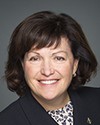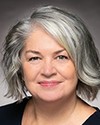Absolutely.
Evidence of meeting #16 for Veterans Affairs in the 42nd Parliament, 1st session. (The original version is on Parliament’s site, as are the minutes.) The winning word was believe.
A recording is available from Parliament.
Evidence of meeting #16 for Veterans Affairs in the 42nd Parliament, 1st session. (The original version is on Parliament’s site, as are the minutes.) The winning word was believe.
A recording is available from Parliament.
Director General, Operations, National Defence and Canadian Forces Ombudsman
Absolutely.
Liberal

Linda Lapointe Liberal Rivière-des-Mille-Îles, QC
As I only have a minute left, my question will be quick.
What measures should be put in place as a priority to ease the transition between military life and civilian life?
Ombudsman, National Defence and Canadian Forces Ombudsman
I think there are many things we can do. I'm going to go back and keep beating my drum to ensure that the releasing member has everything he or she needs for quality of life. This means the basics, enough money for food, heat, and light, and a place to live. It's the basics. Get those in place first.
I think there are many things we can do for transition.
One of the things I don't want to see us do with transition is become dictators about transition. We need to have programs and services available that let the transitioning member self-actualize a little, make some decisions about this vocational rehabilitation program versus that one, and choose the programs and the life that he or she is looking for.
I think we can put some parameters around that, but we also need enough flexibility in the system so that the member can self-actualize. What does their future look like? They need to be part of that solution. If we dictate to them, I don't think we're going to get the results we want. I think it has to be a partnership between the releasing member and the entity itself.
NDP

Irene Mathyssen NDP London—Fanshawe, ON
I wanted to switch horses a little bit here and talk a bit to you about the Deschamps report about sexual harassment and sexual assault in the military.
You stated in May 2015 in terms of your powers that you were excluded from looking at individual sexual harassment and assault issues. Now we've got the Sexual Misconduct Response Centre, as of September 2015. Does this centre fill the need for an independent organization—that is, independent from the military chain of command—to ensure that there's fairness in cases of reported sexual assault or sexual harassment?
Ombudsman, National Defence and Canadian Forces Ombudsman
This office was created in 1998 coming out of Somalia, and if anyone knows the history about Somalia and the issues that arose there, we can say that sexual assault and harassment and conduct unbecoming were some of the catalysts that caused this office to be created.
I wasn't around when they created the office, so I'm not quite sure what authorities were given or were not given to the ombudsman at that point in time, but we have handled and continue to handle sexual assault and sexual harassment complaints at our office. It's a service that we've offered and that I will continue to offer until I have a level of assurance that the system in place is indeed independent and is fully inclusive.
My office deals with not only the uniformed members of the Canadian Armed Forces but also with the employees. This sexual response team does not deal with civilians. We know, those of us who've been around a while, especially in the regions, that military members command civilians and civilians command military members. We've left 28,000 to 30,000 people outside. I don't think that's fair and I live in fairness. That's my role, so as I've said and as I'll continue to say, my office offers the service and will continue to do so until I feel we have a program in place that is fully inclusive and is fair to everybody.
The sexual response team...they call it independent, but it reports to the deputy minister.
NDP

Irene Mathyssen NDP London—Fanshawe, ON
Do you think that the number of incidents reported has risen or that women feel more secure in being able to report incidents of harassment and assault by virtue of this centre being in place?
Ombudsman, National Defence and Canadian Forces Ombudsman
That is my hope. I have no evidence to support that one way or another. I do know there has been activity in the centre. They've gotten a few hundred calls or engagements. There have been some charges laid. It may not be the model I would like to see, but I believe it is bringing light to the issue. I believe it is another avenue that people can utilize if they are experiencing this type of behaviour, so I'll give it kudos for what it is trying to accomplish. Anything we do that raises the level of awareness and roots out this behaviour is good for us.
NDP

Irene Mathyssen NDP London—Fanshawe, ON
You talked about those who are on the outside, the 28,000 to 30,000 individuals. Apart from that, is there any other change in terms of the model that you would like to see?
Ombudsman, National Defence and Canadian Forces Ombudsman
We have just recently asked for and received their procedures. We're doing a thorough review of those now to see what they have included inside of that team. Once I've done that review, madam, I'd be in a better position to answer that question, but we are in the process of doing that as we speak.
NDP

Irene Mathyssen NDP London—Fanshawe, ON
Would that include coverage for women who are struggling to deal with, say, the assault they experienced? This is related to their service. Is it your sense that this is how it should be seen? This is related to their service or their reality when they were a member of the Canadian Forces.
Ombudsman, National Defence and Canadian Forces Ombudsman
If it happened while they were in service, then I think there is a correlation, yes.
NDP

Irene Mathyssen NDP London—Fanshawe, ON
Okay. There shouldn't be any doubt or any equivocation on that?
Ombudsman, National Defence and Canadian Forces Ombudsman
Yes, in my opinion.
NDP

Irene Mathyssen NDP London—Fanshawe, ON
Thank you, and I truly appreciate your opinion.
I did have another question, but I can't find it, so I will yield the floor.
Liberal

Sherry Romanado Liberal Longueuil—Charles-LeMoyne, QC
Thank you.
You've mentioned quite a few solutions that to me seem like pretty common sense. It's basic information. Listen, if you're being released because of an illness, you've been diagnosed. You've received the diagnosis. You shouldn't have to have a new diagnosis once you hit Veterans Affairs.
I'm sure you've been to multiple committees, and we've heard from witnesses that they've come to testify before us before. Why aren't we just getting it done? At one point, we do a lot of talking about it, but what is preventing us from getting these actual action items put in place, in your opinion?
Ombudsman, National Defence and Canadian Forces Ombudsman
I think there are two issues.
One, I think, would be probably an uptick in resource requirement through the Surgeon General, but I believe any money invested there will be more than gained on the other end. It comes down to whether there is leadership and desire. If there is a desire to fix something and you put the right leadership to it, it will get done.
I have to also be cognizant that there is a lot going on in the environment. There are a lot of things going on. We're engaged in multiple theatres. The Canadian Armed Forces are a very busy group. That's the only slack I'll give them.
I believe this comes down to probably a small requirement for resources, and it's just a matter of someone taking this on as a champion and making it happen.
I believe if we continue to have the conversations around what we currently do and doing more of that, we're never going to change. We have to go back and look at the model and say, “It's not working. Let's throw it out and start again.”
I'm not talking about getting rid of resources inside of Veterans Affairs Canada. Hire the case managers you're going to hire. Are they case managers? Maybe they're life coaches, maybe they're something else. Maybe they teach people how to do resumés and the interviewing skills, which we know is a big gap.
There's much we can do, but there is no future in continuing to do what we've done. We're going to keep having this conversation. As you said, in 12 months, in two years, we'll be back having the conversation. I think we're at that point.
Liberal

Sherry Romanado Liberal Longueuil—Charles-LeMoyne, QC
I haven't asked this question, but given the importance of DND and VAC working closely together, do you think the fact that the headquarters of VAC is in Charlottetown causes a problem? Other than the Canadian Space Agency, it's the only government entity that's not in the national capital region. Does that out of sight, out of mind aspect play a factor in maybe not having them work so closely together because they're physically not near each other?
Ombudsman, National Defence and Canadian Forces Ombudsman
I'll be very careful how I answer the question.
Liberal
Ombudsman, National Defence and Canadian Forces Ombudsman
If we look at what we're asking Veterans Affairs Canada to do, which is to provide services and benefits based on the impact on the quality of life of our releasing members, they could be anywhere. I think sometimes a sense of urgency may get lost because of distance.
With the technology we have, the abilities we have, the DM being here in Ottawa, I think it can work, but it goes back to the conversation we've been having at the base of this: it can work, but we're going to have to change the model somewhat.
The world has moved on. We need to move with it. I think Veterans Affairs being in Charlottetown is not a stumbling block. I think the stumbling blocks we're talking about are the current structures we have. I think we need to have a look at those.
I don't see any problem with Veterans Affairs Canada being in Charlottetown.
Liberal

Sherry Romanado Liberal Longueuil—Charles-LeMoyne, QC
In a perfect world, if you had a magic wand, what would you recommend we do in the short term to reduce these wait times? You talked a bit about once the diagnosis happens, you shouldn't have to do it again, and the file transfer, and so on.
What concrete measures can we be taking right now to move toward some quick wins to, first of all, improve the situation—the wait times are ridiculous—and to finally move forward, rip off that Band-Aid, and start making those changes that need to happen? What would you recommend?